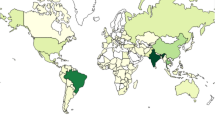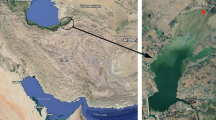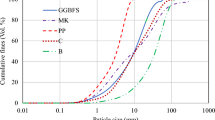Abstract
In this paper, the strength, ductility and microstructure behavior of cement-treated silt with polypropylene fiber was studied by a host of experimental studies. The influence of fiber content (the weight of dry soil was 0.75%, 1.0%, 1.25%, 1.5%, 1.75% and 2.0%), curing time (7, 14 and 28 days) and freeze–thaw cycles (3, 6, 9, 15 and 30) on the unconfined compressive strength (UCS), post-peak stress ratio Rps, resilient modulus MR and mass loss ratio Rml of reinforced silt with 12% cement was discussed in detail. Test results indicated that the addition of polypropylene fiber can improve the UCS of reinforced specimen and the optimal fiber content is 1.75%. Under freeze–thaw cycles, the inclusion of clay with fiber content ranging from 0.75 to 2.0% can increase the UCS. The addition of polypropylene fibers can significantly enhance the post-peak stress ratio of the specimens. The mass loss ratio increased with the number of freeze–thaw cycles. The soil specimens free of fiber were completely destroyed after nine freeze–thaw cycles, while the mass loss rate of the soil specimens with fiber were less than 8%. An empirical model was established to predict the peak value of UCS considering the effect of freeze–thaw cycle and fiber content using logarithmic and quadratic polynomial function, respectively. The predicted results are in good agreement with the tested results. The microstructural study shows that the spatial three-dimensional network between fibers and soil particles is conducive to increase the shear strength of the fiber-reinforced silt. The results indicate that the application of polypropylene fiber in silt reinforcement is an effective way to reuse resources.






















Similar content being viewed by others
Data availability
All data, models, and code generated or used during the study appear in the submitted article.
References
Abou Diab A, Sadek S, Najjar S, Abou Daya MH (2016) Undrained shear strength characteristics of compacted clay reinforced with natural hemp fibers. Int J Geotech Eng 10(3):263–270
Adamo N, Al-Ansari N, Sissakian V, Laue J (2020) Dams safety and geology: dams safety and geology. Earth Sci Geotech Eng 10(6):133–189
Ammar A, Najjar S, Sadek S (2019) Mechanics of the interface interaction between hemp fibers and compacted clay. Int J Geomech 19(4):04019015
Anggraini V, Asadi A, Syamsir A, Huat BB (2017) Three point bending flexural strength of cement treated tropical marine soil reinforced by lime treated natural fiber. Measurement 111:158–166
ASTM C 150/C150M-20. (2002), Standard Specification for Portland Cement. ASTM International, WestConshohocken, PA, 2020. www.astm.org
ASTM D4320/D4320M-09, Standard Practice for Laboratory Preparation of Chemically Grouted Soil Specimens for Obtaining Engineering Parameters. ASTM International, West Conshohocken, PA, 2009. www.astm.org
ASTM D560–03, Standard Test Methods for Freezing and Thawing Compacted Soil-Cement Mixtures. ASTM International, West Conshohocken, PA, 2003. www.astm.org
ASTM D2166/D2166M-16, Standard Test Method for Unconfined Compressive Strength of Cohesive Soil, ASTM International, West Conshohocken, PA, 2016. www.astm.org
ASTM D2487–17e1, Standard Practice for Classification of Soils for Engineering Purposes (Unified Soil Classification System). ASTM International, West Conshohocken, PA, 2017. www.astm.org
ASTM D1997–20, Standard Test Method for Laboratory Determination of the Fiber Content of Peat and Organic Soils by Dry Mass, ASTM International, West Conshohocken, PA, 2020. www.astm.org
Boz A, Sezer A, Ozdemir T, Hizal GE, Dolmaci OA (2018) Mechanical properties of lime-treated clay reinforced with different types of randomly distributed fibers. Arab J Geosci 11:122
Boz A, Sezer A (2018) Influence of fiber type and content on freeze-thaw resistance of fiber reinforced lime stabilized clay. Cold Reg Sci Technol 151:359–366
Cai Y, Shi B, Ng CW, Tang CS (2006) Effect of polypropylene fiber and lime admixture on engineering properties of clayey soil. Eng Geol 87(3–4):230–240
Chen M, Shen S, Arulrajah A, Wu H, Hou D, Xu Y (2015) Laboratory evaluation on the effectiveness of polypropylene fibers on the strength of fiber-reinforced and cement-stabilized Shanghai soft clay. Geotext Geomembr 43(6):515–523
Chu J, Yan SW, Yang H (2000) Soil improvement by the vacuum preloading method for an oil storage station. Geotechnique 50(6):625–632
Claudio P, Luca F, Davide P (2020) Deep tunnel fronts in cohesive soils under undrained conditions: a displacement-based approach for the design of fibreglass reinforcements. Acta Geotech 15(4):1013–1030
Danso H, Manu D (2020) Influence of coconut fibers and lime on the properties of soil-cement mortar. Case Stud Construct Mater 12:e00316. https://doi.org/10.1016/j.cscm.2019.e00316
Ding MT, Zhang F, Lin LXZ (2018) Effects of freeze-thaw cycles on mechanical properties of polypropylene Fiber and cement stabilized clay. Cold Reg Sci Technol 154:155–165
Flores RV, Di Emidio G, Van Impe WF (2009) Small-strain shear modulus and strength increase of cement-treated clay. Geotech Test J 33(1):62–71
Gullu H, Khudir A (2014) Effect of freeze-thaw cycles on unconfined compressive strength of fine-grained soil treated with jute fiber, steel fiber and lime. Cold Reg Sci Technol 106:55–65
Hamidi A, Hooresfand M (2013) Effect of fiber reinforcement on triaxial shear behavior of cement treated sand. Geotext Geomembr 36:1–9
Hansbo S (2005) Experience of consolidation process from test areas with and without vertical drains. In: Elsevier geo-engineering book series, vol 3. Elsevier, pp 3–49
Hejazi SM, Sheikhzadeh M, Abtahi SM, Zadhoush A (2012) A simple review of soil reinforcement by using natural and synthetic fibers. Constr Build Mater 30:100–116
Jamsawang P, Voottipruex P, Tanseng P, Jongpradist P, Bergado Dennes T (2019) Effectiveness of deep cement mixing walls with top-down construction for deep excavations in soft clay: case study and 3D simulation. Acta Geotech 14:225–246
Kang G, Tsuchida T, Kim YS (2017) Strength and stiffness of cement-treated marine dredged clay at various curing stages. Constr Build Mater 132:71–84
Kong Y, Zhou A, Shen F, Yao Y (2019) Stress–dilatancy relationship for fiber-reinforced sand and its modeling. Acta Geotech 14(6):1871–1881
Kumar P, Singh SP (2008) Fiber-reinforced fly ash subbases in rural roads. J Transp Eng 134(4):171–180
Lee W, Bohra NC, Altschaeffl AG, White TD (1995) Resilient modulus of cohesive soils and the effect of freeze–thaw. Can Geotech J 32(4):559–568
Leng J, Ye GL, Ye B, Jeng DS (2017) Laboratory test and empirical model for shear mod-ulus degradation of soft marine clays. Ocean Eng 146:101–114
Li Y, Ling X, Su L, An L, Li P, Zhao Y (2018) Tensile strength of fiber reinforced soil under freeze-thaw condition. Cold Reg Sci Technol 146:53–59
Mohammadinia A, Arulrajah A, Sanjayan J, Disfani, MM, Bo MW, Darmawan S (2015) Geotechnical properties of lightly stabilized recycled demolition materials in base/sub-base applications. In: IFCEE 2015, pp 2767–2776
Namikawa T, Mihira S (2007) Elasto-plastic model for cement-treated sand. Int J Numer Anal Meth Geomech 31(1):71–107
Ng YCH, Xiao H, Armediaz Y, Pan Y, Lee FH (2020) Effect of short fibre reinforcement on the yielding behaviour of cement-admixed clay. Soils Found 60(2):439–453
Pan Y, Liu Y, Lee FH, Phoon KK (2019) Analysis of cement-treated soil slab for deep excavation support–a rational approach. Géotechnique 69(10):888–905
Pan Y, Liu Y, Chen EJ (2019) Probabilistic investigation on defective jet-grouted cut-off wall with random geometric imperfections. Géotechnique 69(5):420–433
Pan Y, Liu Y, Tyagi A, Lee FH, Li DQ (2021) Model-independent strength-reduction factor for effect of spatial variability on tunnel with improved soil surrounds. Géotechnique 71(5):406–422
Pappu A, Saxena M, Asolekar SR (2007) Solid wastes generation in India and their recycling potential in building materials. Build Environ 42(6):2311–2320
Roustaei M, Eslami A, Ghazavi M (2015) Effects of freeze-thaw cycles on a fiber reinforced fine grained soil in relation to geotechnical parameters. Cold Reg Sci Technol 120:127–137
Saygili A, Dayan M (2019) Freeze-thaw behavior of lime stabilized clay reinforced with silica fume and synthetic fibers. Cold Reg Sci Technol 161:107–114
Seed HB, Chan CK, Lee CE (1962) Resilience characteristics of subgrade soils and their relation to fatigue failures in asphalt pavements. In: Int. Conf. Struct. Des. Asph. Pavements, University of Michigan, Ann Arbor, Michigan, pp 611–636
Subramanian S, Khan Q, Ku T (2020) Effect of sand on the stiffness characteristics of cement-stabilized clay. Construct Build Mater 264:120192
Tang C, Shi B, Gao W, Chen F, Cai Y (2007) Strength and mechanical behavior of short polypropylene fiber reinforced and cement stabilized clayey soil. Geotext Geomembr 25(3):194–202
Tang C, Shi B, Zhao LZ (2010) Interfacial shear strength of fiber reinforced soil. Geotext Geomembr 28(1):54–62
Tran KQ, Satomi T, Takahashi H (2018) Improvement of mechanical behavior of cemented soil reinforced with waste cornsilk fibers. Constr Build Mater 178:204–210
Uddin K (1994) Strength and deformation behavior of cement-treated Bangkok Clay (Ph. D. Thesis). Asian Institute of Technology Bangkok Thailand, 27, 89–119
Vitale E, Deneele D, Russo G, Samo D, Nicotera MV, Papa R, Urciuoli G (2020) Chemo-mechanical behaviour of lightweight cemented soils. Acta Geotech 15:933–945
Wang YX, Guo PP, Ren WX, Yuan BX, Yuan HP, Zhao YL, Cao P (2017) Laboratory investigation on strength characteristics of expansive soil treated with jute fiber reinforcement. Int J Geomech 17(11):04017101
Woolridge AC, Ward GD, Phillips PS, Collins M, Gandy S (2006) Lifecycle assessment for reuse/recycling of donated waste textiles compared to use of virgin material: an UK energy saving perspective. Resour Conserv Recycl 46(1):94–103
Xiao H, Lee FH, Chin KG (2014) Yielding of cement-treated marine clay. Soils Found 54(3):488–501
Yan SW, Chu J (2005) Soil improvement for a storage yard using the combined vacuum and fill preloading method. Can Geotech J 42(4):1094–1104
Zhou J, Yu J, Gong X, Naggar M, Zhang R (2020) The effect of cemented soil strength on the frictional capacity of precast concrete pile–cemented soil interface. Acta Geotech 15:3271–3282
Acknowledgements
The funding support from the National Natural Science Foundations of China (No. 51879246; 41831280) and Shandong Provincial Natural Science Foundation, China (No. ZR2019MEE056), are gratefully acknowledged.
Author information
Authors and Affiliations
Corresponding author
Additional information
Publisher's Note
Springer Nature remains neutral with regard to jurisdictional claims in published maps and institutional affiliations.
Rights and permissions
About this article
Cite this article
Kou, Hl., Liu, Jh., Guo, W. et al. Effect of freeze–thaw cycles on strength and ductility and microstructure of cement-treated silt with polypropylene fiber. Acta Geotech. 16, 3555–3572 (2021). https://doi.org/10.1007/s11440-021-01325-3
Received:
Accepted:
Published:
Issue Date:
DOI: https://doi.org/10.1007/s11440-021-01325-3




